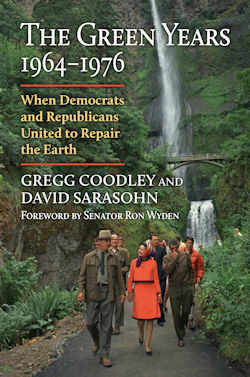SEJournal Online is the digital news magazine of the Society of Environmental Journalists. Learn more about SEJournal Online, including submission, subscription and advertising information.
BookShelf: ‘The Green Years’ — When the Environment Eclipsed Politics
“The Green Years, 1964-1976: When Democrats and Republicans United To Repair the Earth”
By Gregg Coodley and David Sarasohn
University Press of Kansas, $39.95
Reviewed by Nano Riley
 |
It’s time to take another look at the green movement’s history, now that America has celebrated its 52nd Earth Day.
Gregg Coodley and David Sarasohn do a remarkable job of that with their book, “The Green Years, 1964-1976: When Democrats and Republicans United to Repair the Earth,” which reminds us of when Democrats and Republicans put aside differences and joined forces to save our planet.
Coodley, a medical doctor and director of the Fanno Creek Clinic in Portland, Oregon, and David Sarasohn, former Oregonian editor, tell the story of unity.
Even in the midst of the Vietnam War and the domestic unrest of the civil rights movement, it was an era in which warring political parties could find common ground on environmental issues.
Pre-Earth Day milestones
The book begins with the first Earth Day, created on April 22, 1970, by former U.S. Sen. Gaylord Nelson (D-Wis.). Rallies and marches took place across the country, with 20 million people participating.
Nelson was eager to elicit the kind of nationwide support needed to address rising environmental concerns. One of the biggest boosts for the environment came years earlier, though, when then-President Lyndon B. Johnson signed into law the Wilderness Act of 1964.
The Wilderness Act of 1964 set a precedent for future
legislation, resulting in political compromises that led
to the creation of the Clean Water Act in 1972 and
the Toxic Substances Control Act of 1976.
That law defined wilderness as “an area where the earth and its community of life are untrammeled by man,” setting a precedent for future legislation. It resulted in political compromises that led to the creation of the Clean Water Act in 1972 and the Toxic Substances Control Act of 1976, and it set the tone for future legislation.
The book also makes note of an earlier milestone. Rachel Carson had sounded the alarm with her landmark 1962 book, “Silent Spring.” Former U.S. Secretary of Interior Stewart Udall called it “an ecology primer for millions.”
Udall, who earned fame for his unswerving position on environmental issues, for instance by advocating for solar energy during the 1972 energy crisis, went after the U.S. Department of Agriculture for its leniency on pesticides, spotting and strengthening loopholes in the Federal Insecticide, Fungicide, and Rodenticide Act, or FIFRA. Out of an estimated 60,000 complaints over two decades, only about 60 had warranted Agriculture’s attention.
When LBJ signed the revised FIFRA bill, he said the nation was safer for Carson's commitment to exposing the dangers of pesticides.
Nixon’s ‘uneasy feeling’
These and other tidbits throughout this book make it a valuable resource, as well as interesting reading.
For instance, from 1966 through 1969, Nelson introduced bills to ban DDT. But it wasn’t until 1972, under then-President Richard Nixon’s newly-formed U.S. Environmental Protection Agency, that the ban was effected, with the agency’s first administrator, William Ruckelshaus, noting the pesticide seemed less effective with increased use.
But in the winter of 1971-1972, Nixon expressed concerns of major backlash from pro-industry voters if he continued to support stiff environmental regulations. As he cautioned H. R. Haldeman, his chief of staff: “I have an uneasy feeling that perhaps we are doing too much.”
“The Green Years” also sheds light on long-forgotten political players. Among them was former U.S. Sen. Henry “Scoop” Jackson (D-Wash.). He, Udall and others led Congress to enact some important legislation, laying a foundation for today.
Far cry from today’s GOP
The book, which cites renowned environmental historians such as Roderick Nash, Carolyn Merchant, Aldo Leopold and even reaches back to Thomas Jefferson and Henry David Thoreau, ends with an appraisal of those “green years” and how the players are remembered.
At the time, some Republicans still identified
with former President Teddy Roosevelt’s
grand vision, a far cry from today’s GOP.
At the time, some Republicans still identified with former President Teddy Roosevelt’s grand vision, a far cry from today’s GOP. Even while Nixon was concerned about his popularity with the business sector, he was not hostile to environmental issues.
But today’s Republicans, as Coodley and Sarasohn write, are largely from lands hosting mining and big agriculture, while fewer are from the more moderate Northeast. That makes a difference.
With these insights, as well as its copious notes and impressive bibliography, this book earns a well-deserved place on the reference shelf.
Nano Riley is a member of the Society of Environmental Journalists, a journalist, an environmental historian and the author of the 2003 book, “Florida's Farmworkers in the 21st Century.”
* From the weekly news magazine SEJournal Online, Vol. 7, No. 17. Content from each new issue of SEJournal Online is available to the public via the SEJournal Online main page. Subscribe to the e-newsletter here. And see past issues of the SEJournal archived here.

















